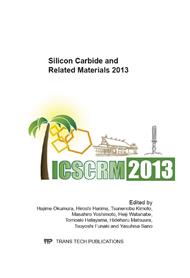[1]
T. Hosoi, K. Konzono, Y. Uenishi, S. Mitani, Y. Nakano, T. Nakamura, T. Shimura, and H. Watanabe: Material Science Forum Vol. 679-680 (2011), p.342.
DOI: 10.4028/www.scientific.net/msf.679-680.342
Google Scholar
[2]
J. Sameshima, O. Ishiyama, Atsushi Shimozato, K. Tamura, H. Oshima, T. Yamashita, T. Tanaka, N. Sugiyama, H. Sako, J. Senzaki, H. Matsuhata, M. Kitabatake: Material Science Forum Vol. 740-742 (2013), p.745.
DOI: 10.4028/www.scientific.net/msf.740-742.745
Google Scholar
[3]
T. Yamashita, H. Matsuhata, Y. Miyasaka, K. Momose, T. Sato and M. Kitabatake: Origin Analyses of Trapezoid-Shape Defects in 4-deg. -off 4H-SiC Epitaxial Wafers by Synchrotron X-ray Topograph, in: present proceedings.
DOI: 10.4028/www.scientific.net/msf.778-780.374
Google Scholar
[4]
O. Ishiyama, K. Yamada, H. Sako, K. Tamura, M. Kitabatake, J. Senzaki and H. Matsuhata: submitted to Jpn. J. Appl. Phys.
Google Scholar
[5]
Y. Ishida and S. Yoshida: Simulation studies on giant step bunching in 4H-SiC epitaxial growth: Cluster effect, in: present proceedings.
DOI: 10.4028/www.scientific.net/msf.778-780.183
Google Scholar
[6]
Y. Ishida, T. Takahashi, H. Okumura, K. Arai and S. Yoshida: Material Science Forum Vol. 600-603 (2009), p.473.
Google Scholar
[7]
The generation of U- and D-GSB is strongly suggested to be related to a defect under the U-GSB. The cluster effect causes GSB regardless of the existence of defects. To estimate only the effect of the defects, therefore, we do not consider the cluster effect.
Google Scholar
[8]
F.C. Frank, in: R.H. Doremus, B.W. Roberts and D. Turnbull (Eds), Growth and Perfection of crystals, Wiley, New York, 1958, pp.411-419.
Google Scholar
[9]
N. Cabrera and D.A. Vermilyea, in: R.H. Doremus, B.W. Roberts and D. Turnbull (Eds), Growth and Perfection of Crystals, Wiley, New York, 1958, pp.393-410.
Google Scholar


